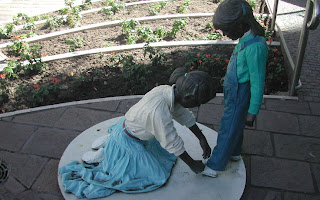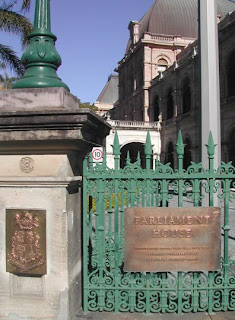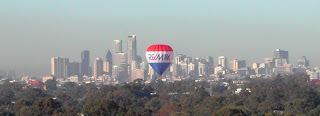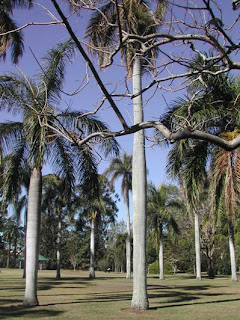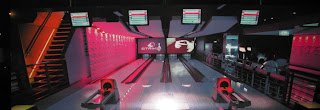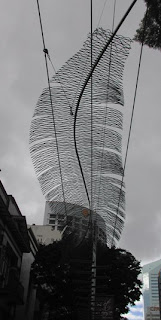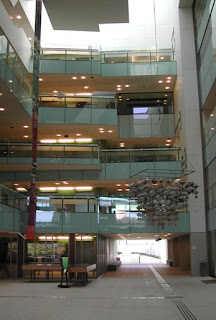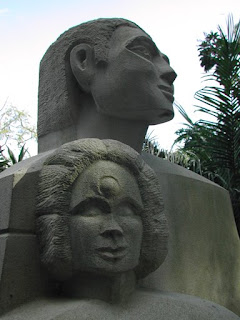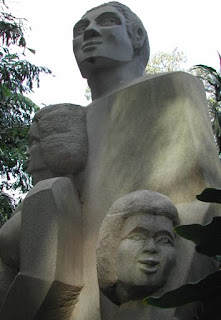 I know I've been slack of late, but it would be remiss of me not to do a post about Christmas in our fair city. Unlike our Northern Hemisphere neighbours, Christmas Down Under is not about snow and shovelling driveways, but rather about beach swimming, sand and sunburn (all of which I've been doing!) Queensland knows how to turn it on, and even though it has been a relatively mild Summer, its still Summer none the less. Even with the sun, Brisbane still does bring out some of the regular sights of Christmas, so I thought I'd bring them out here to share with you in the spirit of Peace, Love and Joy of the Season. My son and I had a walk around the city on Christmas Day, and here are some of the things we found.
I know I've been slack of late, but it would be remiss of me not to do a post about Christmas in our fair city. Unlike our Northern Hemisphere neighbours, Christmas Down Under is not about snow and shovelling driveways, but rather about beach swimming, sand and sunburn (all of which I've been doing!) Queensland knows how to turn it on, and even though it has been a relatively mild Summer, its still Summer none the less. Even with the sun, Brisbane still does bring out some of the regular sights of Christmas, so I thought I'd bring them out here to share with you in the spirit of Peace, Love and Joy of the Season. My son and I had a walk around the city on Christmas Day, and here are some of the things we found. 
Commercialism is still alive and well on the city streets. There were a lot of people in and around the city, and the main restaurants on the Mall were doing a brisk trade. There were also a number of souvenir shops open, and this particular Santa took my eye. Although he's didn't seem as "tanned" in the flesh before we took the photo, the camera doesn't lie. Obviously he'd been out in the Queensland sun as well! Probably taking in the new swimming pool over at South Bank Parklands after his evening of present deliveries. Hey, what better place in the world to have your after work break up?
 At the Myer Centre, the tradition Christmas Windows this year featured "Uno's Garden". Based on the excellent illustrative story by Graeme Base, it depicts a forest, filled with wild and wonderful animals, Uno's unique family and friends. With animals such as the Snortlepig, you know it is going to appeal to kids! Graeme has created some wonderful characters, and it is great to see them brought to life, or at least 3D, in this format. Each year, the Myer window decorators depict scenes like these, along with a traditional Christmas themed window for everyone to enjoy.
At the Myer Centre, the tradition Christmas Windows this year featured "Uno's Garden". Based on the excellent illustrative story by Graeme Base, it depicts a forest, filled with wild and wonderful animals, Uno's unique family and friends. With animals such as the Snortlepig, you know it is going to appeal to kids! Graeme has created some wonderful characters, and it is great to see them brought to life, or at least 3D, in this format. Each year, the Myer window decorators depict scenes like these, along with a traditional Christmas themed window for everyone to enjoy. 
Christmas on the I Love Brisbane Blog wouldn't be complete without a few sculpture images. Within the Mall there are a number of Angel sculptures which have been used to stunning effect overlooking the shoppers and reminding them that it isn't all just about bargains. Surrounded by snowflakes, these works are spectacular, and at night are lit up with small lights to add to the dynamic effect. These sculptures were created by Iceworks Design of Paddington, who spent several months designing and creating sculptures to adorn the Mall.
 Along with the Angels and snowflakes, at the top of the Mall beneath the Christmas tree is a large sculpture of Santa and his reindeer. Riding his sleigh, with it packed full of gifts, he's ready to go. The intricacy of the design is quite astounding, and you can see the immense effort which has gone into these works to highlight the skill of the sculptors. The sculptures are all handmade from stainless steel and acrylic and are illuminated by thousands of LED lights. And on that note, as this will probably be my last post for 2007, I would like to wish everyone a post Merry Christmas, and more importantly a fantastic and Happy New Year. All the best to the readers of this Blog, and I look forward to more posts into 2008.
Along with the Angels and snowflakes, at the top of the Mall beneath the Christmas tree is a large sculpture of Santa and his reindeer. Riding his sleigh, with it packed full of gifts, he's ready to go. The intricacy of the design is quite astounding, and you can see the immense effort which has gone into these works to highlight the skill of the sculptors. The sculptures are all handmade from stainless steel and acrylic and are illuminated by thousands of LED lights. And on that note, as this will probably be my last post for 2007, I would like to wish everyone a post Merry Christmas, and more importantly a fantastic and Happy New Year. All the best to the readers of this Blog, and I look forward to more posts into 2008. 
Cheers, I Love Brisbane, Wes.
Click Here for the Google Map Reference for this post. (The Queen Street Mall)








